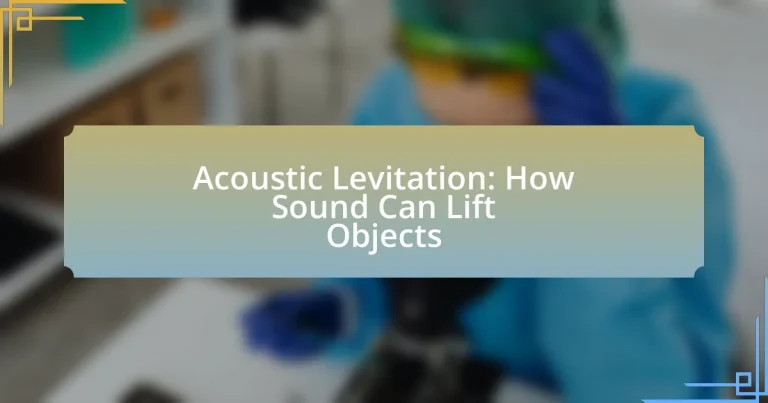Acoustic levitation is a technique that utilizes intense sound waves to lift and manipulate small objects without physical contact, relying on the creation of pressure nodes that counteract gravity. This article explores the principles behind acoustic levitation, including the use of ultrasonic sound waves, and discusses its applications in various fields such as pharmaceuticals, materials science, and scientific research. Additionally, it addresses the advantages and limitations of this technology, the challenges faced in its implementation, and the future prospects for advancements in acoustic levitation. The article highlights how this innovative method can enhance material handling and improve processes across multiple industries.

What is Acoustic Levitation?
Acoustic levitation is a technique that uses intense sound waves to lift and manipulate small objects without physical contact. This phenomenon occurs when sound waves create pressure nodes that can counteract the force of gravity, allowing lightweight materials to float in the air. Research has demonstrated that acoustic levitation can be achieved using ultrasonic frequencies, which are above the range of human hearing, enabling precise control over the levitated objects.
How does Acoustic Levitation work?
Acoustic levitation works by using intense sound waves to create pressure nodes that can counteract the force of gravity on small objects. In this process, ultrasonic waves are emitted from transducers, generating standing waves in the air. These standing waves create regions of high and low pressure, known as nodes and antinodes, respectively. Objects placed at the nodes experience a net upward force due to the pressure differential, allowing them to be suspended in mid-air. This phenomenon has been demonstrated in various experiments, such as those conducted by researchers at the University of Tokyo, where small particles were successfully levitated using ultrasonic sound waves.
What are the principles behind Acoustic Levitation?
Acoustic levitation operates on the principle of using sound waves to create pressure nodes that can counteract the force of gravity on small objects. This phenomenon occurs when high-frequency sound waves are emitted from transducers, generating standing waves in a medium, typically air. The areas of high pressure (antinodes) and low pressure (nodes) formed by these waves create a force that can trap and lift small particles or droplets in the air. Research has demonstrated that acoustic levitation can effectively manipulate objects as small as a few millimeters in size, showcasing its potential applications in material science and pharmaceuticals.
What types of sound waves are used in Acoustic Levitation?
Acoustic levitation primarily utilizes ultrasonic sound waves, which are sound waves with frequencies above the human hearing range, typically above 20 kHz. These ultrasonic waves create standing wave patterns that generate pressure nodes capable of trapping and lifting small particles or droplets in mid-air. The effectiveness of ultrasonic waves in acoustic levitation is supported by their ability to produce high-intensity sound fields, which can exert sufficient force to counteract the gravitational pull on lightweight objects.
What are the applications of Acoustic Levitation?
Acoustic levitation has several applications, including material handling, pharmaceutical development, and scientific research. In material handling, it allows for the manipulation of delicate materials without physical contact, reducing contamination and damage. In the pharmaceutical industry, acoustic levitation is used for drug formulation and testing, enabling precise control over the mixing of compounds. Additionally, scientific research utilizes acoustic levitation for experiments in fluid dynamics and material properties, as it provides a unique environment free from gravitational interference. These applications demonstrate the versatility and utility of acoustic levitation across various fields.
How is Acoustic Levitation used in scientific research?
Acoustic levitation is used in scientific research to manipulate and study small particles without physical contact. This technique allows researchers to suspend materials in mid-air using sound waves, enabling precise control over the environment surrounding the samples. For instance, acoustic levitation has been employed in material science to investigate the properties of liquids and solids at various temperatures and pressures, as it eliminates contamination from containers. Studies have demonstrated that acoustic levitation can facilitate the analysis of chemical reactions and phase transitions, providing insights that are difficult to achieve through traditional methods.
What industries benefit from Acoustic Levitation technology?
Acoustic levitation technology benefits several industries, including pharmaceuticals, materials science, and food processing. In pharmaceuticals, it allows for the manipulation of delicate compounds without contamination, enhancing drug formulation processes. In materials science, it enables the study of materials in a contactless environment, facilitating research on new materials and their properties. In food processing, acoustic levitation can be used for precise ingredient mixing and handling without physical contact, preserving the quality of sensitive food products.

What are the advantages of using Acoustic Levitation?
Acoustic levitation offers several advantages, including the ability to manipulate small particles without physical contact, which minimizes contamination and damage. This technique utilizes sound waves to create pressure nodes that can hold and move objects, making it particularly useful in sensitive applications such as pharmaceuticals and materials science. Additionally, acoustic levitation allows for precise control over the position and orientation of levitated objects, enabling advanced research in fields like fluid dynamics and crystallization processes. The non-invasive nature of this method also facilitates experiments in microgravity-like conditions, enhancing the study of fundamental physical phenomena.
How does Acoustic Levitation compare to other levitation methods?
Acoustic levitation utilizes sound waves to suspend objects in mid-air, distinguishing itself from other levitation methods such as magnetic levitation and electromagnetic suspension. Unlike magnetic levitation, which relies on magnetic fields and requires specific materials to be effective, acoustic levitation can manipulate a wider range of materials, including non-magnetic substances. Additionally, while magnetic levitation often necessitates complex infrastructure and high energy consumption, acoustic levitation operates at lower energy levels and can be implemented in smaller, more portable setups. This versatility is supported by research demonstrating that acoustic levitation can effectively lift and manipulate small particles and droplets, making it valuable in applications like pharmaceuticals and materials science.
What are the safety benefits of Acoustic Levitation?
Acoustic levitation offers significant safety benefits by eliminating physical contact between objects and surfaces, thereby reducing the risk of contamination and damage. This non-contact method allows for the manipulation of delicate materials, such as biological samples or pharmaceuticals, without the risk of mechanical stress or contamination from tools. Additionally, acoustic levitation operates at low temperatures, minimizing the risk of thermal damage to sensitive materials. These advantages make it particularly valuable in fields like materials science and biotechnology, where precision and safety are paramount.
How does Acoustic Levitation enhance material handling?
Acoustic levitation enhances material handling by utilizing sound waves to manipulate and transport small objects without physical contact. This technology allows for precise positioning and movement of materials, reducing the risk of contamination and damage that can occur with traditional handling methods. For instance, in laboratory settings, acoustic levitation can handle delicate samples, such as biological tissues or pharmaceuticals, ensuring their integrity is maintained during transfer. Additionally, it enables the handling of materials in a vacuum or controlled environments, which is crucial for sensitive experiments or manufacturing processes.
What challenges does Acoustic Levitation face?
Acoustic levitation faces several challenges, including the need for precise control of sound waves, limitations in the size and weight of objects that can be levitated, and the requirement for a stable environment to maintain levitation. The control of sound waves is critical because any variation can disrupt the levitation process, making it difficult to achieve consistent results. Additionally, current acoustic levitation techniques are generally limited to small particles or droplets, as larger objects require significantly more energy and complex setups. Environmental stability is also crucial; factors such as air currents or temperature fluctuations can affect the acoustic field, leading to instability in the levitated objects. These challenges highlight the complexities involved in utilizing acoustic levitation effectively in practical applications.
What are the limitations of Acoustic Levitation technology?
Acoustic levitation technology has several limitations, primarily related to the size and weight of objects it can manipulate. This technology typically can only levitate small particles or droplets, usually in the range of milligrams, due to the constraints of sound wave intensity and frequency. Additionally, acoustic levitation requires precise alignment of ultrasonic transducers, which can complicate the setup and limit the range of applications. Furthermore, the technology is sensitive to environmental factors such as temperature and pressure, which can affect the stability of the levitated object. These limitations restrict the practical use of acoustic levitation in larger-scale applications or in environments with variable conditions.
How can these challenges be overcome?
To overcome the challenges of acoustic levitation, researchers can enhance the precision of ultrasonic transducers and optimize the arrangement of sound waves. Improved transducer technology allows for better control of the sound field, which is crucial for stabilizing levitated objects. Additionally, utilizing advanced algorithms for real-time feedback can help maintain the position of objects in the acoustic field, addressing issues related to stability and control. Studies have shown that precise tuning of frequency and phase can significantly increase the effectiveness of acoustic levitation, as demonstrated in experiments published in the Journal of Applied Physics, where researchers achieved stable levitation of small particles using optimized sound wave configurations.

What are the future prospects of Acoustic Levitation?
The future prospects of acoustic levitation include advancements in material handling, pharmaceuticals, and space exploration. Acoustic levitation technology allows for the manipulation of small particles and liquids without physical contact, which can enhance processes in manufacturing and research. For instance, in pharmaceuticals, it can facilitate the development of new drug formulations by enabling precise control over the mixing of compounds. Additionally, in space exploration, acoustic levitation can be utilized to study materials in microgravity conditions, providing insights that are not possible on Earth. These applications are supported by ongoing research and development in the field, indicating a growing interest and investment in acoustic levitation technologies.
How is research advancing in the field of Acoustic Levitation?
Research in the field of Acoustic Levitation is advancing through the development of more precise ultrasonic transducers and improved algorithms for controlling acoustic fields. Recent studies have demonstrated the ability to levitate smaller and lighter objects with greater stability, as seen in the work by researchers at the University of Tokyo, who utilized a phased array of ultrasonic transducers to manipulate the position of levitated particles in real-time. Additionally, advancements in materials science are enabling the levitation of complex structures, such as biological samples, without physical contact, which is crucial for applications in pharmaceuticals and materials processing. These innovations are supported by experimental results showing enhanced control over the levitation process, allowing for more versatile applications in various scientific fields.
What innovations are being explored in Acoustic Levitation technology?
Innovations in Acoustic Levitation technology include the development of more precise control systems for manipulating small particles and liquids using sound waves. Researchers are exploring the use of ultrasonic waves to achieve stable levitation of larger objects, which could enhance applications in material science and pharmaceuticals. For instance, advancements in phased array systems allow for dynamic control of the acoustic field, enabling real-time adjustments to levitation parameters. These innovations are supported by studies demonstrating the effectiveness of acoustic traps in manipulating various materials without physical contact, thus minimizing contamination and damage.
How might Acoustic Levitation impact future industries?
Acoustic levitation may revolutionize future industries by enabling contactless manipulation of materials, which can enhance manufacturing processes and reduce contamination risks. This technology allows for the precise handling of delicate items, such as pharmaceuticals and semiconductors, without physical contact, thereby minimizing defects and improving product quality. For instance, research has demonstrated that acoustic levitation can manipulate small particles and droplets, which could lead to advancements in drug delivery systems and microfabrication techniques. The ability to control materials with sound waves could also lead to innovations in food processing, where it can help maintain the integrity of sensitive ingredients.
What practical tips can be applied when using Acoustic Levitation?
To effectively use acoustic levitation, ensure precise alignment of ultrasonic transducers to create stable standing waves. This alignment is crucial as it directly influences the levitation stability and efficiency. Additionally, maintain optimal frequency settings, typically in the range of 20 kHz to 100 kHz, to achieve effective object manipulation. Research indicates that varying the amplitude of the sound waves can enhance the levitation of different materials, allowing for a broader range of applications. Furthermore, controlling environmental factors such as temperature and humidity can significantly impact the performance of acoustic levitation systems, as these factors can affect sound wave propagation.





